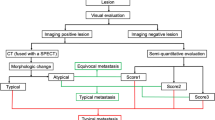Abstract
Bisphosphonates (BisP) are non-metabolized compounds with high bone affinity used in bone metastasis diagnosis and treatment. Currently, BisP are used to treat hypercalcemia of malignancy as well as to prevent, minimize, or delay skeletal morbidity. These compounds have a long half-life in bone. Thus long-term BisP treatment might saturate bone and interfere with a single-dose scanning agent used for bone scintigraphy when visualizing bone metastases. In an effort to answer this question, this study evaluated the concordance of histology and Technetium99 methylene diophosphonate (Tc99 MDP) bone scintigraphy in the diagnosis of bone metastases in prostate cancer patients. We assessed the concordance of findings between bone scintigraphy and histology using 188 bone biopsies from 11 autopsied patients who died with metastatic prostate cancer, 5 of whom were treated with pamidronate for 2 to 13 months before death. Overall agreement between histology and bone scintigraphy was 84%, 86% in non-pamidronate-treated patients and 82% in pamidronate-treated patients. Scintigraphic bone metastases without histological metastasis (false negatives = 12.7%) were observed in 24 anatomic locations; half of these were in one patient who had been treated with pamidronate and had no histological bone response to the carcinoma. There were only 4 sites where a positive bone scan was not associated with histologic metastasis (false positives = 2.21%). There was no statistical difference between the treated and non-treated group for concordance, specificity, sensitivity, positive and negative predictive values of bone scintigraphy and prevalence of histological abnormality. Long-term pamidronate treatment of prostate cancer bone metastases does not generally affect the ability to detect bone metastases with Tc99 MDP bone scintigraphy.
Similar content being viewed by others
References
Galasko CS. Skeletal metastases. Clin Orthop 1986; 18–30.
Ron IG, Striecker A, Lerman H et al. Bone scan and bone biopsy in the detection of skeletal metastases. Oncol Rep 1999; 6: 185–8.
Rogers MJ, Gordon S, Benford HL et al. Cellular and molecular mechanisms of action of bisphosphonates. Cancer 2000; 88: 2961–78.
Lipton A. Bisphosphonates and breast carcinoma: Present and future. Cancer 2000; 88: 3033–7.
Berenson JR, Hillner BE, Kyle RA et al. American Society of Clinical Oncology guideline on the role of bisphosphonates in multiple myeloma. American Society of Clinical Oncology Bisphosphonates Expert Panel. J Clin Oncol 2002; 20: 3719–36.
Saad F, Gleason DM, Murray R et al. A randomized, placebocontolled Trial of zoledronic acid in patients with hormone-refractory metastatic prostate carcinoma. J Natl Cancer Inst 2002; 94: in press.
Hamdy NA, Papapoulos SE. The palliative management of skeletal metastases in prostate cancer: use of bone-seeking radionuclides and bisphosphonates. Semin Nucl Med 2001; 31: 62–8.
Clarke NW, McClure J, George NJ. The effects of orchidectomy on skeletal metabolism in metastatic prostate cancer. Scand J Urol Nephrol 1993; 27: 475–83.
Smith MR, McGovern FJ, Zietman AL et al. Pamidronate to prevent bone loss during androgen-deprivation therapy for prostate cancer. N Engl J Med 2001; 345: 948–55.
Roudier MP, True LT, Higano CS et al. Functional and clonal heterogeneity of bone metastatic prostate cancer. J Urol 2002; 165: 291–2.
Jacobson AF, Stomper PC, Cronin EB et al. Bone scans with one or two new abnormalities in cancer patients with no known metastases: Reliability of interpretation of initial correlative radiographs. Radiology 1990; 174: 503–7.
Paulson DF. Assessment of anatomic extent and biologic hazard of prostatic adenocarcinoma. Urology 1980; 15: 537–41.
Gulenchyn KY, Papoff W. Technetium-99m MDP scintigraphy. An insensitive tool for the detection of bone marrow metastases. Clin Nucl Med 1987; 12: 45–6.
Oyama N, Akino H, Kanamaru H et al. 11C-acetate PET imaging of prostate cancer. J Nucl Med 2002; 43: 181–6.
McCarthy EF. Histopathologic correlates of a positive bone scan. Semin Nucl Med 1997; 27: 309–320.
Galasko CS. The pathological basis for skeletal scintigraphy. J Bone Joint Surg Br 1975; 57: 353–9.
Galasko CS. Detection of bone metastases. Br Med J 1977; 1: 1537.
Masarachia P, Weinreb M, Balena R et al. Comparison of the distribution of 3H-alendronate and 3H-etidronate in rat and mouse bones. Bone 1996; 19: 281–90.
Jung A, Bisaz S, Fleisch H. The binding of pyrophosphate and two diphosphonates by hydroxyapatite crystals. Calcif Tissue Res 1973; 11: 269–80.
Green JR. Chemical and biological prerequisites for novel bisphosphonate molecules: Results of comparative preclinical studies. Semin Oncol 2001; 28: 4–10.
Watt I, Hill P. Effects of acute administration of ethane hydroxydiphosphonate (EHDP) on skeletal scintigraphy with technetium-99m methylene diphosphonic acid (Tc-MDP) in the rat. Br J Radiol 1981; 54: 592–6.
Krasnow AZ, Collier BD, Isitman AT et al. False-negative bone imaging due to etidronate disodium therapy. Clin Nucl Med 1988; 13: 264–267.
Ryan PJ, Gibson T, Fogelman I. Bone scintigraphy following intravenous pamidronate for Paget's disease of bone. J Nucl Med 1992; 33: 1589–93.
Sandler ED, Parisi MT, Hattner RS. Duration of etidronate effect demonstrated by serial bone scintigraphy. J Nucl Med 1991; 32: 1782–4.
Carrasquillo JA, Whatley M, Dyer V et al. Alendronate does not interfere with 99mTc-methylene diphosphonate bone scanning. J Nucl Med 2001; 42: 1359–63.
Pecherstorfer M, Schilling T, Janisch S et al. Effect of clodronate treatment on bone scintigraphy in metastatic breast cancer. J Nucl Med 1993; 34: 1039–44.
Macro M, Bouvard G, Le Gangneux E et al. Intravenous aminohydroxypropylidene bisphosphonate does not modify 99mTchydroxymethylene bisphosphonate bone scintigraphy. A prospective study. Rev Rhum Engl Ed 1995; 62: 99–104.
Boissier S, Magnetto S, Frappart L et al. Bisphosphonates inhibit prostate and breast carcinoma cell adhesion to unmineralized and mineralized bone extracellular matrices. Cancer Res 1997; 57: 3890–4.
Author information
Authors and Affiliations
Corresponding author
Rights and permissions
About this article
Cite this article
Roudier, M., Vesselle, H., True, L. et al. Bone histology at autopsy and matched bone scintigraphy findings in patients with hormone refractory prostate cancer: The effect of bisphosphonate therapy on bone scintigraphy results. Clin Exp Metastasis 20, 171–180 (2003). https://doi.org/10.1023/A:1022627421000
Issue Date:
DOI: https://doi.org/10.1023/A:1022627421000




